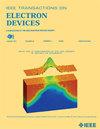Millisecond Pulsed Light Annealing for Improving Performance of Top-Gate Self-Aligned a-IGZO TFT
IF 2.9
2区 工程技术
Q2 ENGINEERING, ELECTRICAL & ELECTRONIC
引用次数: 0
Abstract
The application of millisecond intense pulsed light (IPL) annealing to improve the electrical properties of top-gate self-aligned (TG-SA) amorphous indium gallium zinc oxide (a-IGZO) thin-film transistors (TFTs) was investigated. The IPL annealing with a pulse energy of 40 J/cm2 and a pulsewidth of 20 ms resulted in 53.7% increase in提高顶栅自对准a-IGZO TFT性能的毫秒脉冲光退火
研究了利用毫秒强脉冲光(IPL)退火技术提高顶栅自排列(TG-SA)非晶铟镓锌氧化物(a-IGZO)薄膜晶体管(TFTs)电学性能的方法。脉冲能量为40 J/cm2,脉冲宽度为20 ms的IPL退火得到53.7% increase in $\mu _{\text {FE}}$ and a 128.4% improvement in ${I}_{\text {on}}$ , compared to the unannealed devices. These improvements are attributed to the selective improvement of the specific contact resistivity ( $\rho _{\text {c}}$ ) by the IPL annealing. In addition, positive bias stress (PBS) reliability and temperature-dependent I–V measurements show the improved stability in the IPL-annealed devices and the lower activation energy ( ${E}_{\text {A}}$ ) for charge transport, indicating that the channel region would also have a lower defect density and barrier height for carrier transport.
本文章由计算机程序翻译,如有差异,请以英文原文为准。
求助全文
约1分钟内获得全文
求助全文
来源期刊

IEEE Transactions on Electron Devices
工程技术-工程:电子与电气
CiteScore
5.80
自引率
16.10%
发文量
937
审稿时长
3.8 months
期刊介绍:
IEEE Transactions on Electron Devices publishes original and significant contributions relating to the theory, modeling, design, performance and reliability of electron and ion integrated circuit devices and interconnects, involving insulators, metals, organic materials, micro-plasmas, semiconductors, quantum-effect structures, vacuum devices, and emerging materials with applications in bioelectronics, biomedical electronics, computation, communications, displays, microelectromechanics, imaging, micro-actuators, nanoelectronics, optoelectronics, photovoltaics, power ICs and micro-sensors. Tutorial and review papers on these subjects are also published and occasional special issues appear to present a collection of papers which treat particular areas in more depth and breadth.
 求助内容:
求助内容: 应助结果提醒方式:
应助结果提醒方式:


